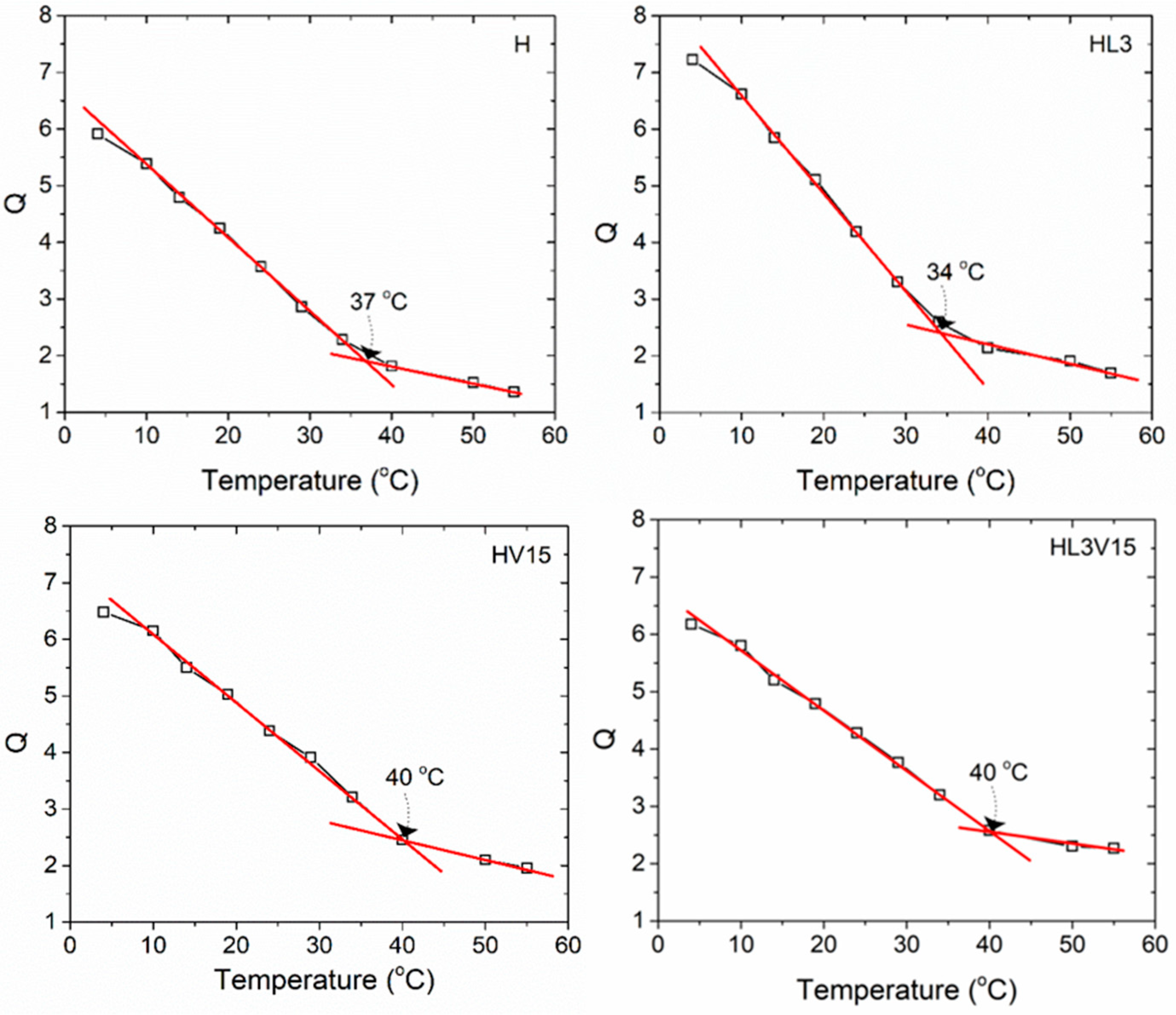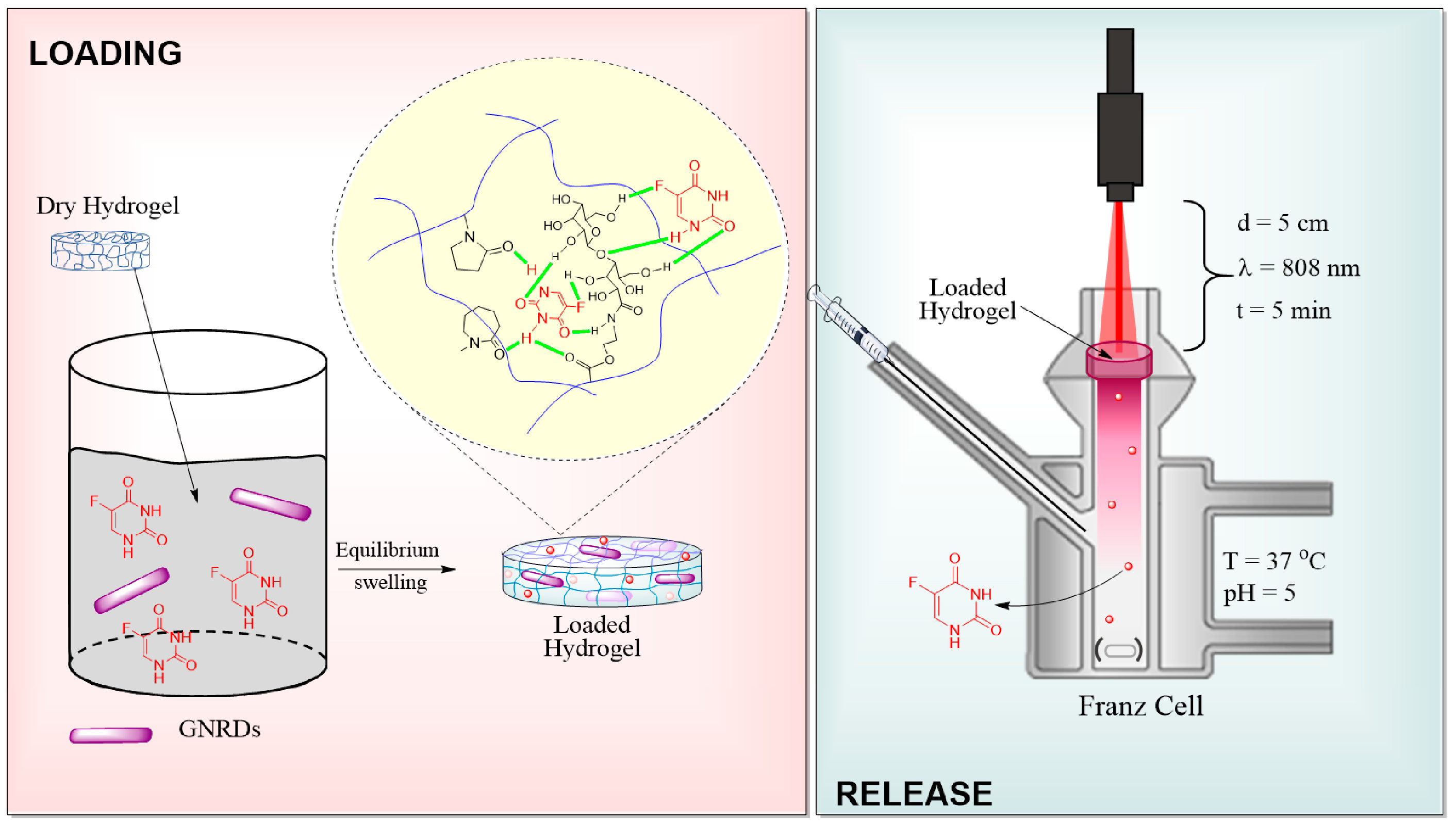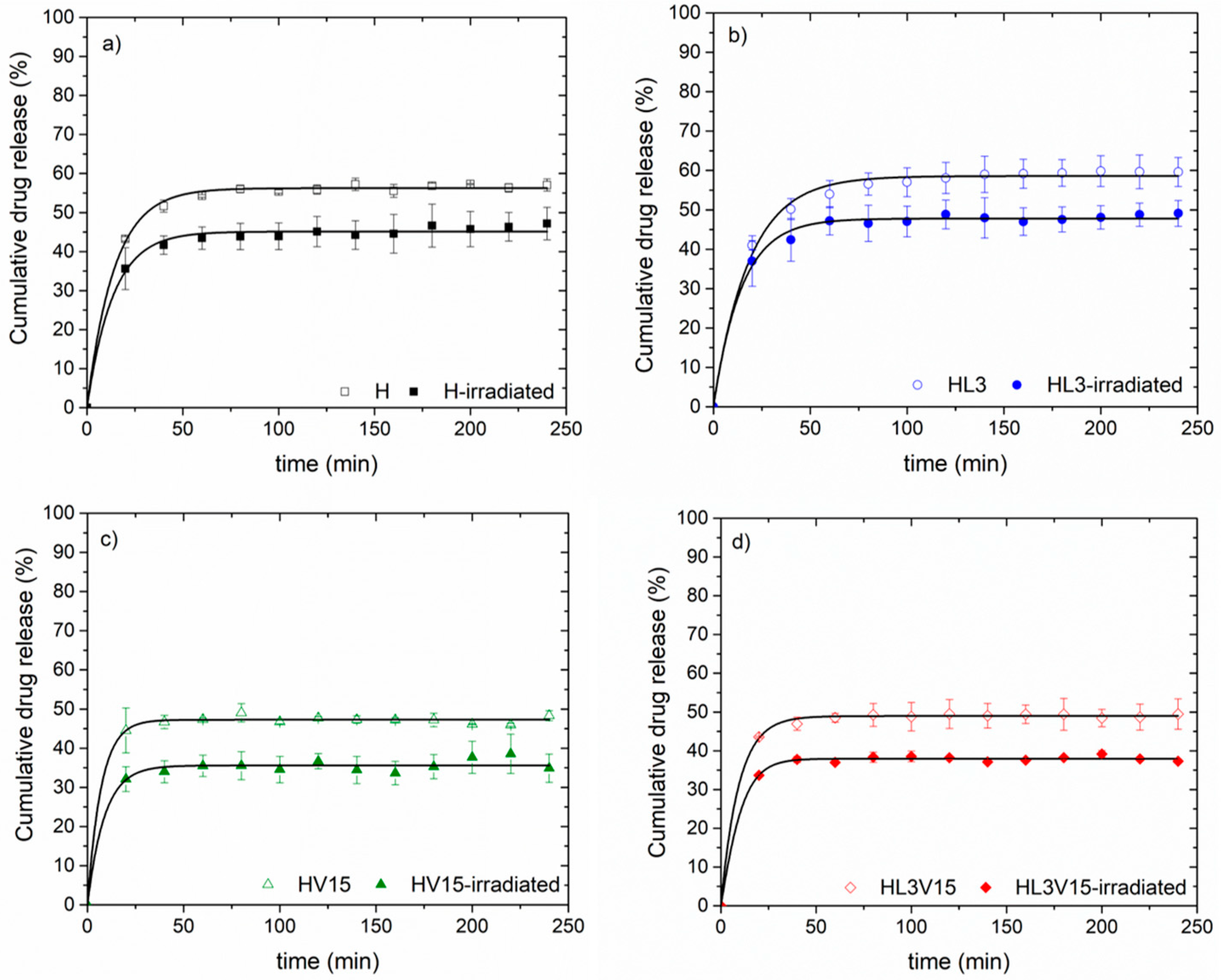Poly(N-vinylcaprolactam)–Gold Nanorods–5 Fluorouracil Hydrogels: In the Quest of a Material for Topical Therapies against Melanoma Skin Cancer
Abstract
:1. Introduction
2. Materials and Methods
2.1. Materials
2.2. Preparation of NVCL-Based Hydrogels by Photopolymerization Method
2.3. Characterization
2.3.1. Swelling Analysis and VPTT Determination
2.3.2. Thermal Analysis by DSC and TGA
2.3.3. Mechanical Analysis
2.3.4. 5FU and GNRDs Loading into Hydrogels
2.3.5. 5FU In Vitro Release Studies
3. Results
3.1. Swelling Behavior and Phase Transition Temperature of PNVCL Hydrogels
3.2. Dry Hydrogel Behavior and Glass Transition Temperature Analysis of NVCL-Based Hydrogels
3.3. Young’s Moduli of Hydrogels at Different Temperatures
3.4. In Vitro Drug Release Studies
3.4.1. Photothermal Analysis of PNVCL Hydrogels with GNRDs
3.4.2. Franz Diffusion Drug Delivery
4. Conclusions
Supplementary Materials
Author Contributions
Funding
Institutional Review Board Statement
Informed Consent Statement
Data Availability Statement
Acknowledgments
Conflicts of Interest
Abbreviations
| 5FU | 5-fluorouracil | n | diffusional exponent |
| AA | ascorbic acid | NIR | near-infrared region |
| CTAB | cetyltrimethylammonium bromide | NVCL | N-vinylcaprolactam |
| DL | drug loading | NVP | N-vinylpyrrolidone |
| DMA | dynamic mechanical analysis | PBS | phosphate-buffered saline |
| DR | drug release | PNVCL | poly(N-vinylcaprolactam) |
| DSC | differential scanning calorimetry | Q | swelling ratio |
| EE | encapsulation efficiency | Tg | glass transition temperature |
| F | fractional drug release | TGA | thermogravimetric analysis |
| GNRDs | gold nanorods | UV–Vis | UV–Vis spectroscopy |
| IRGACURE 651® | 2,2-dimethoxy-2-phenylacetophenone | Vd | volume of dry hydrogel |
| k | release rate constant | VPTT | volume phase transition temperature |
| LAMA | 2-lactobionamidoethyl methacrylate | Vs | volume of swelled hydrogel |
| LSPR | localized surface plasmon resonance | Wd | dry hydrogel mass |
| M0 | initial mass of drug | Ws | swelled hydrogel mass |
| MD | mass of drug | Wsol | weight of the absorbed solvent |
| MDh | mass of drug in the hydrogel | ρd | density of the dry hydrogel |
| Mt | mass of drug at time t | ρso | density of the solvent |
References
- Zeng, L.; Gowda, B.H.J.; Ahmed, M.G.; Abourehab, M.A.S.; Chen, Z.-S.; Zhang, C.; Li, J.; Kesharwani, P. Advancements in nanoparticle-based treatment approaches for skin cancer therapy. Mol. Cancer 2023, 22, 10. [Google Scholar] [CrossRef]
- Siegel, R.L.; Miller, K.D.; Wagle, N.S.; Jemal, A. Cancer statistics, 2023. CA A Cancer J Clin. 2023, 73, 17–48. [Google Scholar] [CrossRef]
- Pópulo, H.; Soares, P.; Lopes, J.M. Insights into melanoma: Targeting the mTOR pathway for therapeutics. Expert Opin. Ther. Targets 2012, 16, 689–705. [Google Scholar] [CrossRef]
- González-Ayón, M.A.; Sañudo-Barajas, J.A.; Picos-Corrales, L.A.; Licea-Claverie, A. PNVCL-PEGMA nanohydrogels with tailored transition temperature for controlled delivery of 5-fluorouracil. J. Polym. Sci. Part A Polym, Chem. 2015, 53, 2662–2672. [Google Scholar] [CrossRef]
- Naves, L.B.; Dhand, C.; Venugopal, J.R.; Rajamani, L.; Ramakrishna, S.; Almeida, L. Nanotechnology for the treatment of melanoma skin cancer. Prog. Biomater. 2017, 6, 13–26. [Google Scholar] [CrossRef] [Green Version]
- Mehan, N.; Kumar, M.; Bhatt, S.; Saini, V. A Current Review on Drug Loaded Nanofibers: Interesting and Valuable Platform for Skin Cancer Treatment. Pharm. Nanotechnol. 2020, 8, 191–206. [Google Scholar] [CrossRef]
- Khan, N.H.; Mir, M.; Qian, L.; Baloch, M.; Khan, M.F.A.; Rehman, A.-U.; Ngowi, E.E.; Wu, D.-D.; Ji, X.-Y. Skin cancer biology and barriers to treatment: Recent applications of polymeric micro/nanostructures. J. Adv. Res. 2022, 36, 223–247. [Google Scholar] [CrossRef]
- Ruiz-Galindo, O.; Zizumbo-López, A.; Licea-Claveríe, A.; Pérez-Sicairos, S. Poly(2-hydroxyethyl methacrylate) hydrogel: From a brittle material to a nanofilled semi-interpenetrating polymer network with potential application in wound dressings. Polym. Int. 2019, 68, 1113–1122. [Google Scholar] [CrossRef]
- Lee, J.H.; Kim, Y.G.; Cho, H.S.; Kim, J.; Kim, S.C.; Cho, M.H.; Lee, J. Thermoresponsive oligomers reduce Escherichia coli O157:H7 biofouling and virulence. Biofouling 2014, 30, 627–637. [Google Scholar] [CrossRef]
- Lee, J.H.; Kim, Y.G.; Lee, K.; Kim, S.C.; Lee, J. Temperature-dependent control of Staphylococcus aureus biofilms and virulence by thermoresponsive oligo(N-vinylcaprolactam): Biofilm Control by Thermoresponsive Polymer. Biotechnol. Bioeng. 2015, 112, 716–724. [Google Scholar] [CrossRef]
- Lee, J.H.; Kim, Y.G.; Lee, J. Inhibition of Candida albicans biofilm and hyphae formation by biocompatible oligomers. Lett. Appl. Microbiol. 2018, 67, 123–129. [Google Scholar] [CrossRef]
- Gonzalez-Urias, A.; Licea-Claverie, A.; Sañudo-Barajas, J.A.; González-Ayón, M.A. NVCL-Based Hydrogels and Composites for Biomedical Applications: Progress in the Last Ten Years. Int. J. Mol. Sci. 2022, 23, 4722. [Google Scholar] [CrossRef]
- Capanema, N.S.V.; Carvalho, I.C.; Mansur, A.A.P.; Carvalho, S.M.; Lage, A.P.; Mansur, H.S. Hybrid Hydrogel Composed of Carboxymethylcellulose–Silver Nanoparticles–Doxorubicin for Anticancer and Antibacterial Therapies against Melanoma Skin Cancer Cells. ACS Appl. Nano Mater. 2019, 2, 7393–7408. [Google Scholar] [CrossRef]
- Roy, R.; Tropper, F.D.; Romanowska, A. Custom-designed glycopolymer syntheses by terpolymerizations. J. Chem. Soc. Chem. Commun. 1992, 1611–1613. [Google Scholar] [CrossRef]
- Glinskii, O.V.; Sud, S.; Mossine, V.V.; Mawhinney, T.P.; Anthony, D.C.; Glinsky, G.V.; Pienta, K.J.; Glinsky, V.V. Inhibition of Prostate Cancer Bone Metastasis by Synthetic TF Antigen Mimic/Galectin-3 Inhibitor Lactulose-l-Leucine. Neoplasia 2012, 14, 65–73. [Google Scholar] [CrossRef] [Green Version]
- Nangia-Makker, P.; Hogan, V.; Honjo, Y.; Baccarini, S.; Tait, L.; Bresalier, R.; Raz, A. Inhibition of Human Cancer Cell Growth and Metastasis in Nude Mice by Oral Intake of Modified Citrus Pectin. JNCI J. Natl. Cancer Inst. 2002, 94, 1854–1862. [Google Scholar] [CrossRef] [Green Version]
- Inohara, H.; Raz, A. Effects of natural complex carbohydrate (citrus pectin) on murine melanoma cell properties related to galectin-3 functions. Glycoconj. J. 1994, 11, 527–532. [Google Scholar] [CrossRef]
- Shen, W.; Chang, Y.; Liu, G.; Wang, H.; Cao, A.; An, Z. Biocompatible, Antifouling, and Thermosensitive Core−Shell Nanogels Synthesized by RAFT Aqueous Dispersion Polymerization. Macromolecules 2011, 44, 2524–2530. [Google Scholar] [CrossRef]
- Johnson, K.D.; Glinskii, O.V.; Mossine, V.V.; Turk, J.R.; Mawhinney, T.; Anthony, D.; Henry, C.J.; Huxley, V.H.; Glinsky, G.V.; Pienta, K.; et al. Galectin-3 as a Potential Therapeutic Target in Tumors Arising from Malignant Endothelia. Neoplasia 2007, 9, 662–670. [Google Scholar] [CrossRef] [PubMed] [Green Version]
- Chauhan, D.; Li, G.; Podar, K.; Hideshima, T.; Neri, P.; He, D.; Mitsiades, N.; Richardson, P.; Chang, Y.; Schindler, J.; et al. A Novel Carbohydrate-Based Therapeutic GCS-100 Overcomes Bortezomib Resistance and Enhances Dexamethasone-Induced Apoptosis in Multiple Myeloma Cells. Cancer Res. 2005, 65, 8350–8358. [Google Scholar] [CrossRef] [Green Version]
- Björnmalm, M.; Thurecht, K.J.; Michael, M.; Scott, A.M.; Caruso, F. Bridging Bio–Nano Science and Cancer Nanomedicine. ACS Nano 2017, 11, 9594–9613. [Google Scholar] [CrossRef]
- Dalton, M.B.; Halligan, S.C.; Killion, J.A.; Wang, W.; Dong, Y.; Nugent, M.; Geever, L.M. The Effect Acetic Acid has on Poly(N-Vinylcaprolactam) LCST for Biomedical Applications. Polym. Plast. Technol. Eng. 2018, 57, 1165–1174. [Google Scholar] [CrossRef]
- González-Ayón, M.A.; Licea-Claverie, A.; Sañudo-Barajas, J.A. Different Strategies for the Preparation of Galactose-Functionalized Thermo-Responsive Nanogels with Potential as Smart Drug Delivery Systems. Polymers 2020, 12, 2150. [Google Scholar] [CrossRef] [PubMed]
- Liu, J.; Detrembleur, C.; De Pauw-Gillet, M.C.; Mornet, S.; Duguet, E.; Jérôme, C. Gold nanorods coated with a thermo-responsive poly(ethylene glycol)-b-poly(N-vinylcaprolactam) corona as drug delivery systems for remotely near infrared-triggered release. Polym. Chem. 2014, 5, 799–813. [Google Scholar] [CrossRef] [Green Version]
- González-Ayón, M.A.; Licea-Rodriguez, J.; Méndez, E.R.; Licea-Claverie, A. NVCL-Based Galacto-Functionalized and Thermosensitive Nanogels with GNRDs for Chemo/Photothermal-Therapy. Pharmaceutics 2022, 14, 560. [Google Scholar] [CrossRef] [PubMed]
- Ilavský, M.; Mamytbekov, G.; Bouchal, K.; Hanyková, L. Phase transition in swollen gels. Polym. Bull. 1999, 43, 109–116. [Google Scholar] [CrossRef]
- Cortez-Lemus, N.A.; Licea-Claverie, A. Poly(N-vinylcaprolactam), a comprehensive review on a thermoresponsive polymer becoming popular. Prog. Polym. Sci. 2016, 53, 1–51. [Google Scholar] [CrossRef]
- Cerda-Sumbarda, Y.D.; Domínguez-González, C.; Zizumbo-López, A.; Licea-Claverie, A. Thermoresponsive nanocomposite hydrogels with improved properties based on poly(N-vinylcaprolactam). Mater. Today Commun. 2020, 24, 101041. [Google Scholar] [CrossRef]
- Beik, J.; Abed, Z.; Ghoreishi, F.S.; Hosseini-Nami, S.; Mehrzadi, S.; Shakeri-Zadeh, A.; Kamrava, S.K. Nanotechnology in hyperthermia cancer therapy: From fundamental principles to advanced applications. J. Control. Release 2016, 235, 205–221. [Google Scholar] [CrossRef]
- Mirrahimi, M.; Abed, Z.; Beik, J.; Shiri, I.; Dezfuli, A.S.; Mahabadi, V.P.; Kamrava, S.K.; Ghaznavi, H.; Shakeri-Zadeh, A. A thermo-responsive alginate nanogel platform co-loaded with gold nanoparticles and cisplatin for combined cancer chemo-photothermal therapy. Pharmacol. Res. 2019, 143, 178–185. [Google Scholar] [CrossRef]
- Fu, W.; Zhang, X.; Mei, L.; Zhou, R.; Yin, W.; Wang, Q.; Gu, Z.; Zhao, Y. Stimuli-Responsive Small-on-Large Nanoradiosensitizer for Enhanced Tumor Penetration and Radiotherapy Sensitization. ACS Nano 2020, 14, 10001–10017. [Google Scholar] [CrossRef] [PubMed]
- Li, Q.; Hang, L.; Jiang, W.; Dou, J.; Xiao, L.; Tang, X.; Yao, Y.; Wang, Y. Pre- and post-irradiation mild hyperthermia enabled by NIR-II for sensitizing radiotherapy. Biomaterials 2020, 257, 120235. [Google Scholar] [CrossRef] [PubMed]
- Trucillo, P. Drug Carriers: A Review on the Most Used Mathematical Models for Drug Release. Processes 2022, 10, 1094. [Google Scholar] [CrossRef]
- Ramteke, K.H. Mathematical Models of Drug Dissolution: A Review. Sch. Acad. J. Pharm. 2014, 3, 388–396. [Google Scholar]
- Ilgin, P.; Ozay, H.; Ozay, O. A new dual stimuli responsive hydrogel: Modeling approaches for the prediction of drug loading and release profile. Eur. Polym. J. 2019, 113, 244–253. [Google Scholar] [CrossRef]









| Sample | LAMA Content (a) (wt%) | NVP Content (a) (mol%) | Q at 25 °C | Q at 37 °C | VPTT (°C) |
|---|---|---|---|---|---|
| H | - | - | 3.4 ± 0.07 | 2.1 ± 0.02 | 37.0 |
| HL1 | 1 | - | 3.7 ± 0.03 | 2.2 ± 0.00 | 36.5 |
| HL2 | 2 | - | 3.9 ± 0.03 | 2.3 ± 0.06 | 36.0 |
| HL3 | 3 | - | 4.0 ± 0.09 | 3.4 ± 0.02 | 34.0 |
| HV5 | - | 5 | 3.8 ± 0.19 | 2.4 ± 0.07 | 38.5 |
| HV10 | - | 10 | 4.1 ± 0.06 | 2.7 ± 0.06 | 39.0 |
| HV15 | - | 15 | 4.2 ± 0.02 | 3.0 ± 0.02 | 40.0 |
| HL3V5 | 3 | 5 | 3.6 ± 0.04 | 2.5 ± 0.02 | 40.0 |
| HL3V10 | 3 | 10 | 3.7 ± 0.12 | 2.6 ± 0.13 | 40.0 |
| HL3V15 | 3 | 15 | 4.1 ± 0.02 | 2.9 ± 0.03 | 40.0 |
| Sample | Young’s Modulus (a) (kPa) at 25 °C | Strain (%) | Young’s modulus (a) (kPa) at 37 °C | Strain (%) |
|---|---|---|---|---|
| H | 114 ± 6 | 23 ± 1.5 | 142 ± 12 | 41 ± 2.0 |
| HL1 | 60 ± 2 | 34 ± 0.4 | 127 ± 27 | 35 ± 2.3 |
| HL2 | 49 ± 4 | 37 ± 0.4 | 85 ± 13 | 42 ± 0.4 |
| HL3 | 43 ± 1 | 38 ± 1.2 | 91 ± 16 | 39 ± 2.0 |
| HV5 | 93 ± 4 | 31 ± 1.0 | 107 ± 7 | 33 ± 3.0 |
| HV10 | 84 ± 5 | 28 ± 1.0 | 89 ± 9 | 36 ± 1.2 |
| HV15 | 76 ± 1 | 29 ± 0.6 | 120 ± 20 | 32 ± 0.7 |
| HL3V5 | 93 ± 9 | 29 ± 0.7 | 114 ± 1 | 38 ± 1.0 |
| HL3V10 | 92 ± 4 | 30 ± 2.5 | 287 ± 19 | 27 ± 2.3 |
| HL3V15 | 78 ± 6 | 30 ± 0.7 | 191 ± 37 | 32 ± 2.7 |
| Hydrogel | 5FU Loading (wt%) | Encapsulation Efficiency (%) | GNRD Loading (wt%) |
|---|---|---|---|
| H | 4.03 ± 0.4 | 51.48 ± 0.3 | 3.78 ± 0.3 |
| HL3 | 2.99 ± 0.0 | 47.50 ± 0.3 | 4.65 ± 0.9 |
| HV15 | 3.92 ± 0.3 | 51.09 ± 3.2 | 4.12 ± 0.1 |
| HL3V15 | 4.93 ± 1.3 | 52.50 ± 10.2 | 5.66 ± 0.2 |
| Hydrogel | Model | Release Rate (k) | Regression Coefficient (r2) | ||
|---|---|---|---|---|---|
| Not Irradiated | Irradiated | Not Irradiated | Irradiated | ||
| H | Zero order | 0.0002 | 0.0002 | 0.58 | 0.86 |
| First order | 0.0004 | 0.0004 | 0.59 | 0.86 | |
| Higuchi | 0.0111 | 0.0050 | 0.69 | 0.87 | |
| Peppas | 0.3575, | 0.2876, | 0.76 | 0.86 | |
| n = 0.09 | n = 0.09 | ||||
| HL3 | Zero order | 0.0006 | 0.0004 | 0.64 | 0.53 |
| First order | 0.0009 | 0.0006 | 0.76 | 0.55 | |
| Higuchi | 0.0092 | 0.0047 | 0.83 | 0.58 | |
| Peppas | 0.3715, | 0.2985, | 0.90 | 0.78 | |
| n = 0.09 | n = 0.09 | ||||
| HV15 | Zero order | 0.0007 | 0.0006 | 0.96 | 0.88 |
| First order | 0.0013 | 0.0009 | 0.96 | 0.89 | |
| Higuchi | 0.0096 | 0.0081 | 0.97 | 0.93 | |
| Peppas | 0.3956, | 0.2755, | 0.61 | 0.73 | |
| n = 0.04 | n = 0.05 | ||||
| HL3V15 | Zero order | 0.0009 | 0.0005 | 0.90 | 0.67 |
| First order | 0.0008 | 0.0007 | 0.68 | 0.64 | |
| Higuchi | 0.0079 | 0.0062 | 0.75 | 0.73 | |
| Peppas | 0.3822, | 0.2817, | 0.82 | 0.77 | |
| n = 0.05 | n = 0.05 | ||||
Disclaimer/Publisher’s Note: The statements, opinions and data contained in all publications are solely those of the individual author(s) and contributor(s) and not of MDPI and/or the editor(s). MDPI and/or the editor(s) disclaim responsibility for any injury to people or property resulting from any ideas, methods, instructions or products referred to in the content. |
© 2023 by the authors. Licensee MDPI, Basel, Switzerland. This article is an open access article distributed under the terms and conditions of the Creative Commons Attribution (CC BY) license (https://creativecommons.org/licenses/by/4.0/).
Share and Cite
González-Ayón, M.A.; Rochin-Galaviz, A.; Zizumbo-López, A.; Licea-Claverie, A. Poly(N-vinylcaprolactam)–Gold Nanorods–5 Fluorouracil Hydrogels: In the Quest of a Material for Topical Therapies against Melanoma Skin Cancer. Pharmaceutics 2023, 15, 1097. https://doi.org/10.3390/pharmaceutics15041097
González-Ayón MA, Rochin-Galaviz A, Zizumbo-López A, Licea-Claverie A. Poly(N-vinylcaprolactam)–Gold Nanorods–5 Fluorouracil Hydrogels: In the Quest of a Material for Topical Therapies against Melanoma Skin Cancer. Pharmaceutics. 2023; 15(4):1097. https://doi.org/10.3390/pharmaceutics15041097
Chicago/Turabian StyleGonzález-Ayón, Mirian A., Alondra Rochin-Galaviz, Arturo Zizumbo-López, and Angel Licea-Claverie. 2023. "Poly(N-vinylcaprolactam)–Gold Nanorods–5 Fluorouracil Hydrogels: In the Quest of a Material for Topical Therapies against Melanoma Skin Cancer" Pharmaceutics 15, no. 4: 1097. https://doi.org/10.3390/pharmaceutics15041097
APA StyleGonzález-Ayón, M. A., Rochin-Galaviz, A., Zizumbo-López, A., & Licea-Claverie, A. (2023). Poly(N-vinylcaprolactam)–Gold Nanorods–5 Fluorouracil Hydrogels: In the Quest of a Material for Topical Therapies against Melanoma Skin Cancer. Pharmaceutics, 15(4), 1097. https://doi.org/10.3390/pharmaceutics15041097








